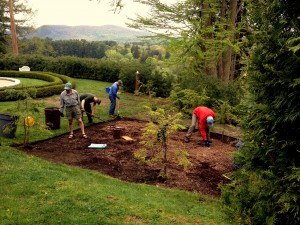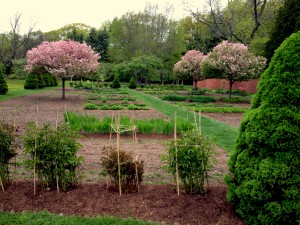Growing things at historic sites
11 October 2013 – Kate Preissler
- I’ve written before about differences I see between education and engagement as strategies (and goals) for programming at cultural sites. Two features crucial to making programs “engaging” as well as “educational” are:
- The inclusion of activities that encourage visitors to use multiple senses and their full concentration, freeing the mind from other thoughts and distractions; and
- Information or activities that cause some type of positive change in individuals beyond their visit to the site.
At The Trustees of Reservations, the staff members at many of its historic and cultural sites have been implementing a range of projects which allow visitors, volunteers, and community members to become involved in planting, tending, and harvesting gardens of all sorts. In some cases the gardening activities are clearly part of the work of “doing history” while in others the gardening activities make use of the site’s landscape to offer engaging opportunities for participants and benefits for the host community.
There are few activities as completely immersive and engaging as getting people’s hands into the dirt of gardens. Gardening requires a person to put down the camera and phone. It engages all of the senses – touch, sight, smell, taste, sound – and it requires concentration from the individual, which helps him or her let go of distractions.
In addition, gardening provides real health and well-being benefits for participants. The health benefits of gardening include the more obvious like fresh air and exercise but also some more subtle advantages like lowering rates of depression and anxiety. Gardening activities can positively impact the quality of life for participants beyond their time at the site, especially if there are ongoing opportunities or other ways to make it a regular part of their routine.

Members of the public participate in a garden restoration workday at Naumkeag, MA. Credit: Kate Preissler
Some of the different ways that people have engaged in gardening activities at Trustees sites include:
- Skill-Building Workshops: At several of the sites, small-scale gardens were constructed for the sole purpose of education and engagement. At sites such as The Bullitt Reservation, these gardens provide an outdoor classroom for people to learn a variety of gardening techniques and strategies which they could then take home and implement in their own yards. Kitchen gardens, native pollinator gardens, pizza gardens, and cold frames can all be taught simply and inexpensively and can be recreated fairly easily by participants at their homes.
- Service-Learning Activities: Manicured gardens, especially those that are being preserved to reflect a particular historical appearance, require constant upkeep. There are several program models that combine information about preservation, the past, or archival records with actually going out and getting some work done in the gardens. Service-learning programs can be one-day events or they can, like the Horticultural Internship program at Naumkeag be much more in-depth and ongoing activities.
- Pick-Your-Own Fields: The flower fields at Long Hill were created as a way to allow visitors, especially families with kids, to engage with the gardens in an easy and casual way while also generating some income. The Flower Fields immerse visitors in the smells, sights, and sounds of the flowers and pollinators, while the act of picking flowers to create bouquets allows them to touch and feel the flowers and take some home.
- Work and Learn: Several of our farms have programs that integrate “work and learn” opportunities for young people. At Westport Town Farm and The Bradley Estate, full Youth Conservation Corps teams of paid teenagers were created to maintain the farm areas and bring the vegetables to farmer’s markets and local food pantries. Other locations host 4H clubs and “Farm Hand” youth groups.
- Demonstration Gardens: Demonstration gardens can be great features of sites that don’t have deep staff resources. Gardens can enable a lot of immersive self-guided activities like sensory scavenger hunts or flower pressing that can be tied to stories and information from the past. While some places might have demonstration areas of garden features that would have been historically consistent with the site, there are opportunities for other themes as well. At Long Hill, for instance, The Trustees have built demonstration sustainable gardens to contrast with the preserved historical gardens that are maintained around the estate.
- Volunteer Garden Stewards: Like service-learning programs, volunteer programs are designed to support the maintenance and upkeep of the landscapes as well as engage individuals and groups. At the Stevens-Coolidge Place, a group of ongoing volunteers, under the leadership of a staff member, researched archival materials on the gardens, restored some French-inspired features at the site, and continue to conduct regular maintenance of the gardens. This provides them with education, training, and an ongoing opportunity to physically work on the gardens they love, while relieving the staff of some pressure.
As we all continue to expand our views from the interiors of historic homes to the full landscape of a site, garden and growing programs seem like a natural way to engage visitors in a wide range of topics, stories, and learning.
These are just a few examples, but my guess is that people have done some exciting things in your landscapes: What kinds of activities have you done at your sites that got visitors’ hands down into the dirt? Were they successful?
~ Kate Preissler is the former Western Region Engagement Manager for The Trustees of Reservations. Kate holds a B.A. from Bates College in English and History and graduated from the University of Massachusetts at Amherst Public History Masters Program in 2010.




